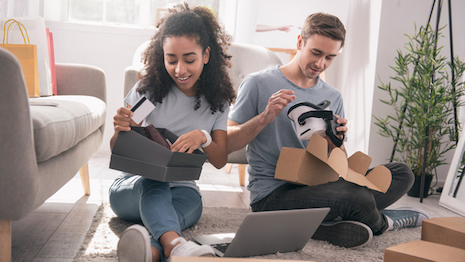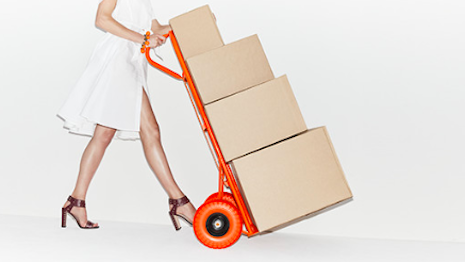 OrderDynamics found that retailers are lagging in BOPIS adoption. Image credit: OrderDynamics
OrderDynamics found that retailers are lagging in BOPIS adoption. Image credit: OrderDynamics
Luxury retailers are failing to leverage click-and-collect services, with only a third of high-end brands offering an option to buy online and pick up in store.
According to a new report from OrderDynamics, even those retailers that do offer click-and-collect often take more than a day to fulfill orders or neglect to promote the service prominently on their Web sites. Consumers who shop across channels are highly valuable, typically buying more often and spending more, positioning retailers that offer cross-channel options to reach this “superconsumer."
"Luxury brands are the perfect fit for click-and-collect," said Charles Dimov, vice president of marketing at OrderDynamics, Richmond Hill, Canada. "When you consider that 40 to 59 percent of customers purchase additional goods when they come into a store to pick up an item, luxury brands can capitalize on this to drive sales revenue higher, on every deal.
"After all, you already know the shopper likes your brand and style," he said. "A further upsell, or additional sale, is an easy next step."
OrderDymamics’ Omni-2000 report is based on the company’s consumer-facing experiences on about 2,000 retailer Web sites.
Omnichannel opportunity
All but 13 percent of the brands studied by OrderDynamics have an ecommerce capability, and most online retailers offer free shipping to consumers who spend a certain amount on a transaction. Luxury retailers, department stores and home furnishings sellers fittingly have a higher average threshold for complimentary delivery compared to more mass retailers.
 Nordstrom local is one of many retailers that offers services such as curbside pickup and buy online, pickup in-store. Image credit: Nordstrom
Beyond home delivery, OrderDymamics found that 37.6 percent of all retailers have adopted click-and-collect. However, luxury brands studied showed less likelihood of having this option available.
Buy online pick up in store (BOPIS) is most prevalent in the United Kingdom, where almost two-thirds of retailers offer click-and-collect. Retailers with bigger store footprints are also more apt to offer BOPIS.
Fifty-seven percent of those that do have click-and-collect market the service on their homepage. OrderDynamics notes the missed opportunity for the other half of drawing attention to its availability.
Despite giving shoppers another ecommerce fulfillment option through click-and-collect, most retailers only offer customers one pick-up option and one type of notification.
Recent research from OrderDynamics shows that click-and-collect services are more popular among female consumers with higher annual incomes, exhibiting the importance of luxury retailers including these services.
According to the report, the “click-and-collect superconsumer” is 24 to 49 years old and has been well versed in omnichannel retail for the last two years. This consumer is also interested in the experience of shopping, needing to touch and feel the products she is purchasing (see story).
Nordstrom local is one of many retailers that offers services such as curbside pickup and buy online, pickup in-store. Image credit: Nordstrom
Beyond home delivery, OrderDymamics found that 37.6 percent of all retailers have adopted click-and-collect. However, luxury brands studied showed less likelihood of having this option available.
Buy online pick up in store (BOPIS) is most prevalent in the United Kingdom, where almost two-thirds of retailers offer click-and-collect. Retailers with bigger store footprints are also more apt to offer BOPIS.
Fifty-seven percent of those that do have click-and-collect market the service on their homepage. OrderDynamics notes the missed opportunity for the other half of drawing attention to its availability.
Despite giving shoppers another ecommerce fulfillment option through click-and-collect, most retailers only offer customers one pick-up option and one type of notification.
Recent research from OrderDynamics shows that click-and-collect services are more popular among female consumers with higher annual incomes, exhibiting the importance of luxury retailers including these services.
According to the report, the “click-and-collect superconsumer” is 24 to 49 years old and has been well versed in omnichannel retail for the last two years. This consumer is also interested in the experience of shopping, needing to touch and feel the products she is purchasing (see story).
 While consumers have changed the way they shop, bricks-and-mortar retail is still vital. Image credit: Neiman Marcus
Most of the superconsumers surveyed by OrderDynamics expect their click-and-collect orders to be ready within 24 hours, but only 35 percent of retailers commit to this timeframe.
"For luxury brand items, it is to the customer’s advantage to pick these products up rather than risk an item becoming lost or stolen when left at a doorstep, or with the concierge desk of a condominium," Mr. Dimov said. "Even if shipping cost is not a concern to the retailer, customer satisfaction is something to be prioritized.
"In-store pickup gives luxury retailers the opportunity to provide one more excellent service touchpoint," he said. "It further solidifies the loyalty effect.
"Luxury retailers who do offer the convenience of click-and-collect will start capturing more of the customers who want this service. The danger is in losing customer loyalty by not offering BOPIS when your competitors do offer it."
Another aspect of omnichannel shoppers that retailers are missing is visibility of inventory availability. Less than four in 10 retailers show this information on product pages.
Some opt instead to only show availability once an item is out of stock, which OrderDynamics refers to as “passive inventory visibility.”
Outside of acquiring goods via multiple channels, consumers want to be able to return merchandise from ecommerce orders to a physical store.
About 73 percent of retailers with an omnichannel presence do accept ecommerce returns at their stores.
While retailers are likely to grant shoppers free shipping for their purchases, they are less apt to pay for return shipping. Only three in 10 retailers studied offer free shipping for returns, which may be creating a barrier for consumers to buy online.
The most common window for returns is 30 to 59 days, with Canadian and U.S. retailers most likely to use this timeframe.
Cross-channel consumers
Consumers today have mastered the art of seamlessly transitioning between online, offline and mobile shopping, and retailers must adapt to this new reality.
A report from Criteo found that only 7 percent of consumers are omnichannel shoppers yet cross-channel shopping accounts for 27 percent of all sales. For retailers, adjusting to the way customers shop now, freely switching between shopping on their phones, online at home or in store is paramount to future success (see story).
Time itself is a luxury, and retailers should focus on eliminating hurdles in the purchase path.
Amazon has set the bar high for streamlined shopping experiences, raising consumer expectations for a frictionless transaction. The “Clicks and Bricks: Why Luxury Retail Needs to Innovate” panel during Luxury FirstLook 2018: Exclusivity Redefined, speakers stressed the necessity for innovation to remove obstacles to buying (see story).
"Most retailers can accelerate omnichannel services by bringing in smart order management technology," Mr. Dimov said. "A good system will integrate with a retailer’s existing infrastructure to make omnichannel possible. It makes sure that orders are routed to the right place: the right store closest to a shopper for easy pick-up. It provides real-time inventory visibility for customers online and gives the retailer the ability to accept returns, whether originally online purchases or bought from the store.
"However, retailers need to consider speed of deployment of these systems, as well as the ability to integrate with existing technologies," he said. "A retailer should not have to rip and replace their existing retail technology stack to be able to make BOPIS happen in their stores.
"Key priorities include selecting a solid order management system that integrates well with your existing technology, a good ecommerce platform that allows for detailed and dynamic inventory visibility and provides the interface you need to represent your brand and an excellent systems integrator who knows how to pull these technologies together into a converged commerce solution."
While consumers have changed the way they shop, bricks-and-mortar retail is still vital. Image credit: Neiman Marcus
Most of the superconsumers surveyed by OrderDynamics expect their click-and-collect orders to be ready within 24 hours, but only 35 percent of retailers commit to this timeframe.
"For luxury brand items, it is to the customer’s advantage to pick these products up rather than risk an item becoming lost or stolen when left at a doorstep, or with the concierge desk of a condominium," Mr. Dimov said. "Even if shipping cost is not a concern to the retailer, customer satisfaction is something to be prioritized.
"In-store pickup gives luxury retailers the opportunity to provide one more excellent service touchpoint," he said. "It further solidifies the loyalty effect.
"Luxury retailers who do offer the convenience of click-and-collect will start capturing more of the customers who want this service. The danger is in losing customer loyalty by not offering BOPIS when your competitors do offer it."
Another aspect of omnichannel shoppers that retailers are missing is visibility of inventory availability. Less than four in 10 retailers show this information on product pages.
Some opt instead to only show availability once an item is out of stock, which OrderDynamics refers to as “passive inventory visibility.”
Outside of acquiring goods via multiple channels, consumers want to be able to return merchandise from ecommerce orders to a physical store.
About 73 percent of retailers with an omnichannel presence do accept ecommerce returns at their stores.
While retailers are likely to grant shoppers free shipping for their purchases, they are less apt to pay for return shipping. Only three in 10 retailers studied offer free shipping for returns, which may be creating a barrier for consumers to buy online.
The most common window for returns is 30 to 59 days, with Canadian and U.S. retailers most likely to use this timeframe.
Cross-channel consumers
Consumers today have mastered the art of seamlessly transitioning between online, offline and mobile shopping, and retailers must adapt to this new reality.
A report from Criteo found that only 7 percent of consumers are omnichannel shoppers yet cross-channel shopping accounts for 27 percent of all sales. For retailers, adjusting to the way customers shop now, freely switching between shopping on their phones, online at home or in store is paramount to future success (see story).
Time itself is a luxury, and retailers should focus on eliminating hurdles in the purchase path.
Amazon has set the bar high for streamlined shopping experiences, raising consumer expectations for a frictionless transaction. The “Clicks and Bricks: Why Luxury Retail Needs to Innovate” panel during Luxury FirstLook 2018: Exclusivity Redefined, speakers stressed the necessity for innovation to remove obstacles to buying (see story).
"Most retailers can accelerate omnichannel services by bringing in smart order management technology," Mr. Dimov said. "A good system will integrate with a retailer’s existing infrastructure to make omnichannel possible. It makes sure that orders are routed to the right place: the right store closest to a shopper for easy pick-up. It provides real-time inventory visibility for customers online and gives the retailer the ability to accept returns, whether originally online purchases or bought from the store.
"However, retailers need to consider speed of deployment of these systems, as well as the ability to integrate with existing technologies," he said. "A retailer should not have to rip and replace their existing retail technology stack to be able to make BOPIS happen in their stores.
"Key priorities include selecting a solid order management system that integrates well with your existing technology, a good ecommerce platform that allows for detailed and dynamic inventory visibility and provides the interface you need to represent your brand and an excellent systems integrator who knows how to pull these technologies together into a converged commerce solution."
